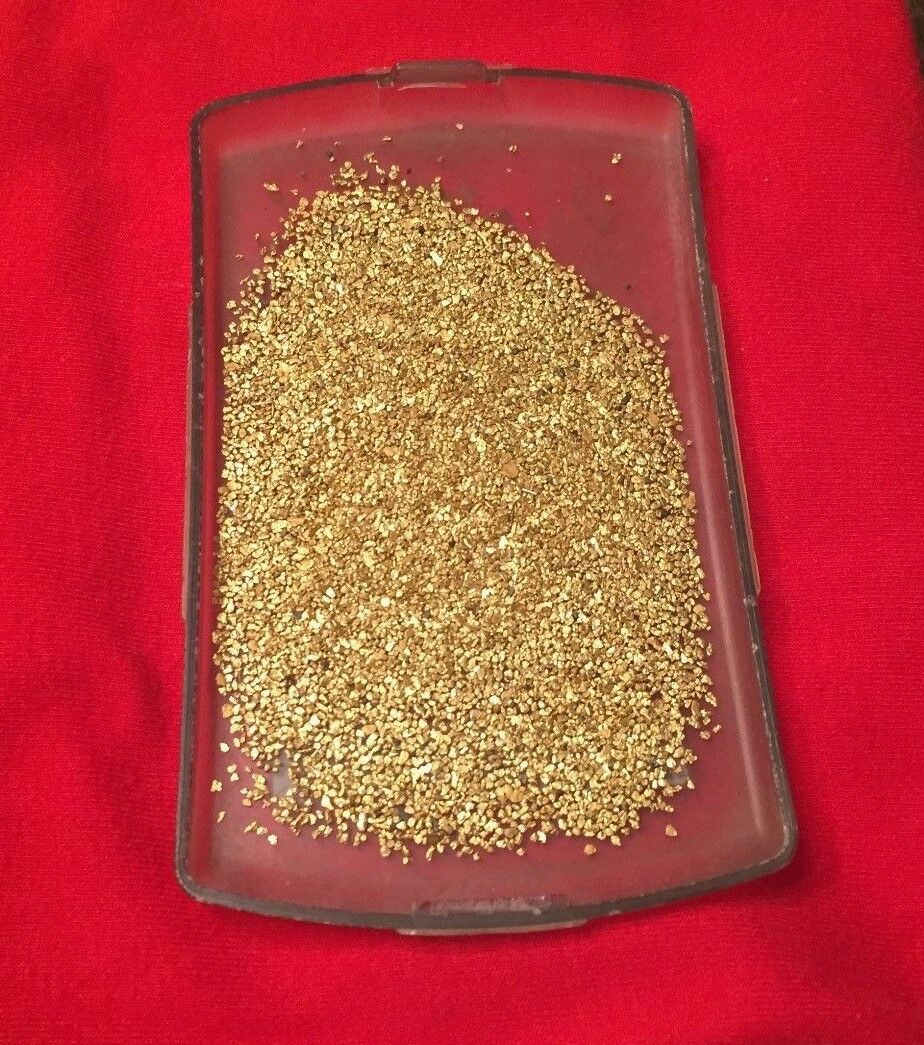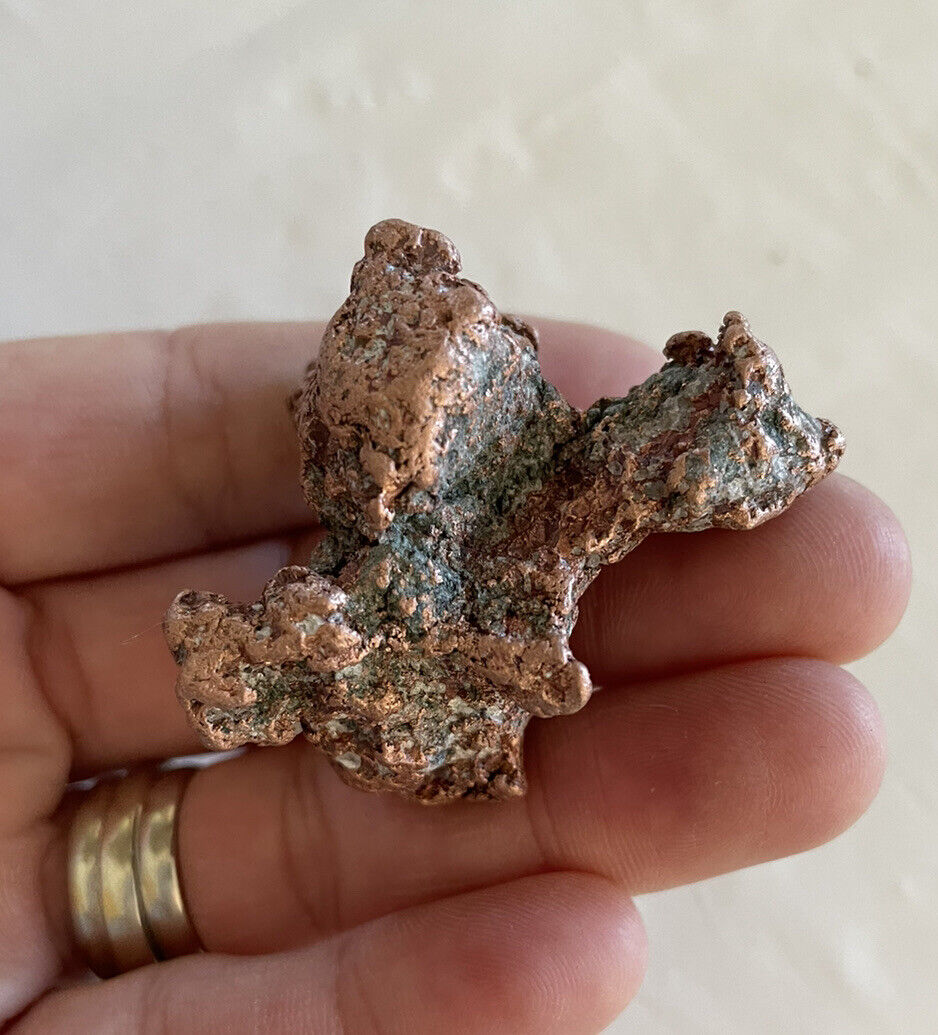-40%
NATURAL GREY GOLD QUARTZ SPECIMEN 10.1 GRAMS NATIVE CALIFORNIA GOLD IN QUARTZ
$ 68.64
- Description
- Size Guide
Description
NATIVE GOLD QUARTZ SPECIMENfrom the
MOTHER LODE
R
uler is
1/4"
wide (6 mm). U.S. 10 cent coin is 17 mm in diameter.
S
pecimen weight:
155.7
G
rains (Troy) -
10.1
G
ram
S
ize:
57.7X15.1X8.7
mm
C
heck out this heavily-mineralized, grey quartz from the Sierra Nevada Mtns. After all these years in 'the trade', I'm forever blown away by how many different ore types were produced and unearthed in the Mother Lode. Each day brings another surprise. Thick clumps of gold are always a good sign a prospector is where he needs to be. That's what lies embedded at one end of this two-tone grey, schistic rock. The 'whiter shade of pale' grey quartz grades into a darker, pyrite and gold-infested cap. Near the opposite end, a nice-show of gold is also visible within the lighter-colored quartz. Anytime a prospector finds exposures of raw, high-purity Au in a rock, he has a reason to sing. My elderly VLF machine gives off a good, crisp zip!
The signal's not violent, but in the field, you definitely would want to check it out. Washing off your new find and
seeing gold, your heart would go 'pitter patter' with joy. This will make an exquisite micromount - a very interesting and unique piece containing a lively spectrum of colorful minerals. You won't be getting your money's worth unless you understand this isn't bullion, a nugget, or jewelry, it's a primo gold quartz specimen. I guarantee it's altogether natural. Source is California.
Here, you have embryonic gold direct from the womb with silicon dioxide (quartz) attached. All my specimens show visible gold and are
authentic
gold nuggets, gold quartz, or other gold and silicate specimens.
U.S. SHIPPING .00
(includes USPS tracking to all U.S. destinations)
INTERNATIONAL CUSTOMERS S&H
.00 (with my apologies, for the cost just keeps going up)
FAST REFUND OFFERED
(If, for any reason, you're not happy with this item). Contact me indicating you wish to return the item. As soon as it's received by me and everything's as it should be, you'll be issued a refund.
I poured through old mining dumps for years looking at orange-yellow-rusty rock through a loupe, but I never found a piece with visible gold.
Hydrothermal solutions carrying gold and silica crystallized into veins of gold quartz. This specimen comes from one of the many vein systems sourcing the immense placer deposits of the Sierra Nevada Mtns, the famed Mother Lode.
Weight Conversions:
15.43 GRAINS = 1 GRAM
31.103 GRAMS = 1 TROY OUNCE
24 GRAINS = 1 PENNYWEIGHT (DWT)
20 DWT = 1 TROY OUNCE
480 GRAINS = 1 TROY OUNCE
S&H
Discounted for combined shipments.
PAYMENTS
For U.S. buyers: We accept paypal
For intnl. customers: We accept paypal.
Pay securely with
www.paypal
.
Payment must be made within 7 days from close of auction. We ship as soon as funds clear. If you have questions, please ask them before bidding.
REFUNDS
We leave no stones un-turned insuring our customers get what they bargained for.
If you're not satisfied with this item, contact me. Then, if the problem can't be fixed, return product within 30 days in 'as purchased' condition for a full refund
ARROWHEAD NUGGET
With so many adventures in the field to draw from, I’ll just relate this one.
In 1987, I began metal detecting a sizable drainage which empties into a California river. On previous trips, several 1 to 2 pennyweight nuggets had been recovered, so I continued my search further up the creek for potential gold haunts. Every nugget dug in these diggings had, up until now, come from a high bar deposit. These terraces, measuring ten to a hundred yards or more in width, had been worked extensively for several miles. Historically, it was these older alluvial formations which shelled out the best gold. From all indications, these gravels had been mined years earlier using hydraulic cannons (giants) and hand tools. Judging from the mountains of boulders stacked neatly in the numerous excavations, a variety of mining methods had been employed. Written accounts tell of gin poles used as rock-lifting and transfer mechanisms. Walled-up pathways zig-zagged between these boulders piles which, in places, reached heights of fifteen feet.
Where water cannons had been directed, besides the aforementioned stacked rocks, little remained except deep raceways, sheer, cleaved-off faces at the back of the mined-out cuts, and barren, exposed bedrock upon which the richest, gold-bearing gravels had once lain.
Every drive along the creek was another hunt for previously unnoticed cuts or hand-diggings. When in a mining district, one should diligently research mining records to determine who owns what. It's always advisable to seek permission before conducting any manner of mining or prospecting on valid claims. Whether it’s hostile action or civil, there will be no mistaking a claimowner's intent should they object to an unauthorized entry for the purpose of removing (their) minerals. One quickly realizes the error of his ways confronted by an irate claimholder with fire in his eye and, possibly, bullets in his gun. If you are claim-jumping, chances are good you will be proclaimed as such and told to leave the premises immediately. Mineral trespass is never something to be taken lightly. Such practice, in some areas, may be commonplace, but it's not an activity I would ever encourage anyone to engage in.
A few miles up from the confluence of this tributary with the main river channel, I spotted a hydraulic cut which bore further investigation. After a short, but steep hike down into a small, V-shaped feeder-creek, I followed a trail up the opposite bank into a sizable expanse of exposed old channel. Initial
efforts to score weren't rewarded yet offered encouraging signs. The second trip proved substantially more successful with three quarters of an ounce of gold falling victim to their electromagnetism. With excitement at a peak, I resumed the hunt a few days later.
Through the years, many old placer diggings were worked repeatedly and often. As a result, they almost always contain prodigious amounts of ferrous junk from all this mining activity. Searching a portion of the hydraulic cut previously overlooked and seeing this was the case, I decided to dig every target. In such ground conditions, searches for TOVs (targets of value) can prove frustrating and tedious. Yet, the alternative of not digging targets, but leaving them unidentified should be given serious consideration. I know from experience such neglect can negate your chances of finding, perhaps,
the one monster nugget in an excavation. On this occasion, I opted to clear the field of every metallic target. For this purpose, magnets make excellent detecting aids since they make quick work of eliminating most ferrous-junk signals.
N
ear the lowest elevation in the cut
, a series of jagged bedrock ridges, three or four feet apart, acted like small channels or gutters in the bluestone (schist). These bedrock crevices were packed full of detritus. The lay of the land suggested gold-bearing gravels had been channeled and flushed through this depressed area. From this staging area, it's quite likely they were pushed through sluice boxes later deserted at the site. Over the course of several decades, these wooden boxes had eventually disintegrated. An over-abundance of rusty square nails probably discouraged other treasure hunters from expending too much energy searching this zone. I knew full well how tiresome digging up these less-desirable targets can be. Even now, my pockets bulged with old nails, but I continued on with my search. One V-shaped channel, about 12 inches deep, contained nails by the score. Resolutely, I unearthed every single object emitting a metallic signal, all of them ferrous unfriendlies
until finally, lodged at the very bottom of the crevice lay something of greater value. Thinking back, I did not spot it immediately. The material loosened by my Estwing hammer was
scooped out and scattered around the digsite. Standard practice for me was to isolate a target with the detector,
take a handful of material, swipe it across the top of the coil, then make another pass over the dirt with my coil to confirm the target’s location. I continue this process until the
prey is in my hand. It was at this point I spotted my prize. Later at the cabin, my powder scales showed the smooth, arrowhead-shaped nugget weighed a hefty 12 pennyweights.
This, to the average nugget-shooter, represented no earth-shaking find, but for argonauts like myself, accustomed to working days on end for a few paltry grains of color, it was a rare treasure, a golden find to write home about – the stuff of dreams, legends, and lies.
Thanks for checking out our digs.
G
old of
E
ldorado
8-13-17
















